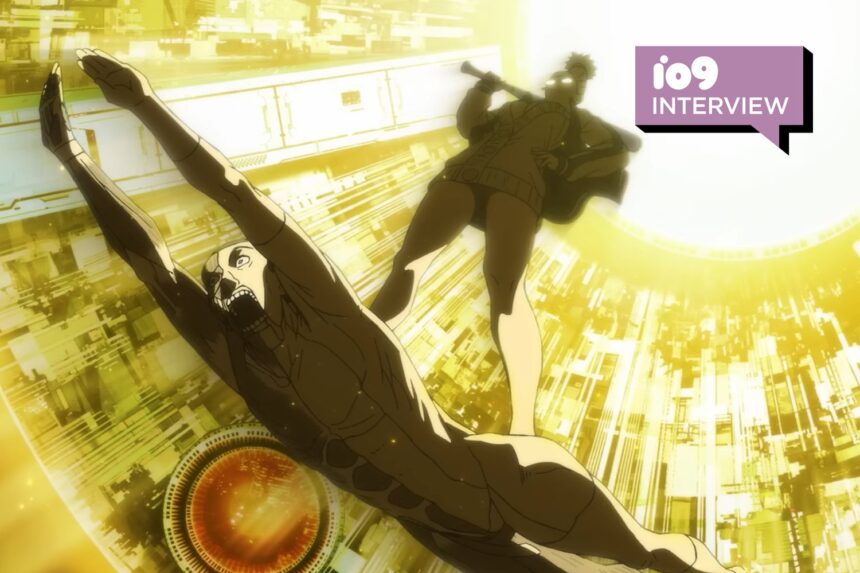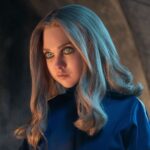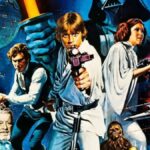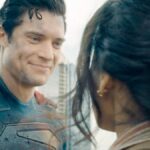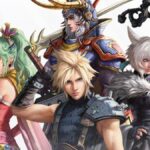Dan Da Dan is poised to make its highly anticipated return to streaming platforms this July. Ahead of the yokai-meets-sci-fi anime series’ second season, studio Science Saru and GKids have joined forces once more with Dan Da Dan: Evil Eye, a theatrical premiere featuring the first three episodes of its forthcoming season. They pick up right where the season one cliffhanger left off adapting creator Yukinobu Tatsu’s ongoing manga.
While the theatrical event includes an insightful interview video with its directors, io9 pierced the veil even further, chatting with Abel Gongora, the opening theme director of Dan Da Dan‘s first season and co-director for its upcoming season. During our conversation, Gongora reflected on the pop culture influences that inspired his creative process and his evolving role co-directing alongside longtime collaborator Fuga Yamashiro—and how their shared creative vision and occasional artistic disagreements contributed to the tag-team ebb and flow of Dan Da Dan season two’s early production.
This interview has been edited for clarity.
Isaiah Colbert, io9: Season one ended on a suspenseful cliffhanger that left fans eager for more. Was that always the plan from the start, or did the decision evolve during production to build anticipation for season two?
Abel Gongora: That was decided at the very beginning—that’s more like a script decision. They have the manga already, so they can see where they want to cut, and that was done very early in the production.
io9: This time around, you’re stepping into a co-director role instead of just handling the show’s opening, which featured shadowy silhouettes and bold, Kon Ichikawa-styled typography. What led to that shift from being the opening director to the co-director for season two?
Gongara: After the opening, I started to assist [Yamashiro] also. I got involved in the project, and then I got to understand important things to know, like the characters’ story. It went kind of smooth because I was already in season [one] a little bit. The production is really difficult—it’s a lot of work to do one season. Production thought it would be good to have two directors so the work is not too hard on the season one director. I started with all the setting designs that we had at the end of season one, then it was already decided, so I kind of slowly started [directing] in season two.
io9: Dan Da Dan’s opening theme by Creepy Nuts became an instant fan favorite and even won a couple of anime awards. The sequence features clear nods to pop culture iconography, such as Ultraman, blending bold stylistic choices with the show’s unique energy. What inspired that creative direction, and do you have a personal favorite moment from its opening sequence?
Gongara: At that time, I talked with the director of season one [and] he gave me total freedom because we have worked together for a long time. He knows, more or less, my style. He just asked me to use Ultraman as a reference—those silhouette pictures. He’d say, “As long as you use that, it’s okay. You can do whatever you want.” So I started watching Ultraman and I started to find some ideas on how to use it, and I also added something extra to make another kind of scenes in the opening. We agreed we didn’t want to have the normal look of the show, so it looks a little bit more like shiny fancy colors—a little bit more special.
I showed all the ideas and concepts to the director. He liked it. Then I started I started the storyboard when I got the song. I thought the song was really cool, so it was exciting to do the storyboard, because you have to feel the rhythm and find ideas according to the rhythm of the song. Yamashiro was really open to everything. It was difficult, but it was fun.
My favorite part is the silhouette that I did myself. And then some of the rough animation cuts that were done by one guy on the team, who is a really amazing animator. I was very happy because I asked him if he could do it on paper and pencil. The picture, like the grain of the paper, is on the screen. If you stop the frame, it has the real grain of the paper, and then the real pencil. That is something we don’t do any more in animation. It’s kind of like a lot of work, and I’m very happy this animator did it. It turned out to be very beautiful. Also, I did the compositing at the end because I wanted to push that rough style. Yeah, those parts are my favorite in the opening.
io9: Will season two’s opening, “On My Way” by AiNA THE END, follow a similar approach to using silhouettes like the first season did, or can audiences expect something entirely new meshing with the poppy sound of AiNA’s song?
Gongara: It’s gonna be completely different. I cannot say much, but it’s gonna be really different and I’m happy about it. I think it’s amazing. I wanted something different, because otherwise it might look like trying to redo something that was good, and I thought that wouldn’t be interesting. But yeah, you will see.
io9: In the Evil Eye director interview, you mentioned watching and drawing heavy inspiration from horror films and Hong Kong cinema to help shape your approach to the Evil Eye arc. What films helped you nail Dan Da Dan’s action-meets-horror atmosphere in season two?
Gongara: The main reference for Dan Da Dan would be Ultraman, of course. I really liked the way Hideaki Anno did the new version of Ultraman, Shin Ultraman. We also have kaiju and things like that, so I really liked Shin Godzilla and Shin Kamen Rider. There’s also some common points with Kung Fu movies. They sometimes share similar storytelling, with one influencing the other. For example, like a crush-zoom on the face of a character, things like that are used a lot in both media. We try to analyze those things.
I’m also very influenced by the Alien movies. That also fits Dan Da Dan‘s science fiction part, and it’s very scary. I think the original Alien is a really amazing film. I don’t think there’s really a movie that mixes all this, but we try to get the ideas and general influence by watching a lot of films. I think Yamashiro-san would do that, too.
io9: The first season was a huge visual spectacle, effortlessly shifting between horror, action, and romance with expressive animation that heightened every moment. Were there any specific scenes from the manga that pushed the studio creatively in season two? Moments where animation allowed the series to take things to another level, but proved to be a challenge to get over the finish line?
Gongara: (laughs) We are in the middle of [production] today. We are trying new things like mixing 3D sometimes to help the animators. Sometimes, we have ideas that cannot be done by traditional animation, or it would be crazy to do. We are trying to find how to use 3D in a more creative way. There’s a little bit in Evil Eye, too. We are experimenting a little bit with the 3D. We also have a lot of new music in the season, and we are experimenting a little bit with the way we use it.
io9: You’ve mentioned that you and Yamashiro have worked together before, in a collaborative setting. How has the meshing of both your styles to create Dan Da Dan season two been? Has it proved to be a rough feeling-out process working through where you guys disagree creatively, or has it been a seamless transition for the two of you?
Gongara: I think, of course, [Yamashiro] has more heavy involvement because he decided all the things you can see in season one, and I tried to follow his direction. Of course, we don’t agree on everything. But we have half of the season divided. It’s not exactly like half-and-half. It’s like I’ve got the first arc, then he gets the second arc, and then I go back for the third arc, and then he’s also doing something later. We share like that, but still, we are involved in both. Sometimes, he’s helped me adding some storyboard parts or some ideas he had, and I’d also check with him [on] colors. Things like that we need to decide because some designs might appear in both my episode and his episode. We are working all the time together.
We have this background where we used to work in many projects together. [We’ve worked] with Masaki Yuuasa before, and we learned a lot from him. So we have similar vision. We agree on many things and our view on animation and cinema is similar. We like to push perspective and we like to push the expression of the characters, maybe more than other directors. It’s kind of not too hard for both [of us], I hope. I cannot talk for him, but I think it’s smooth in general.
Dan Da Dan season two premieres this July on Netflix, Crunchyroll, and Hulu. Evil Eye hits theaters across the U.S. June 6.
Want more io9 news? Check out when to expect the latest Marvel, Star Wars, and Star Trek releases, what’s next for the DC Universe on film and TV, and everything you need to know about the future of Doctor Who.
Read the full article here

